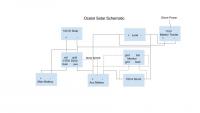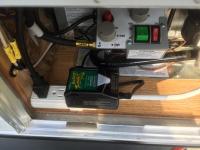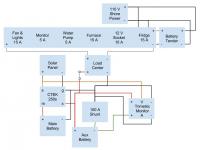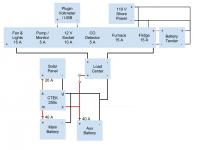I am reasearching options for adding solar to my Ocelot next year. I had the Ocelot pre-wired so I won’t have to tare into it to add solar. I’m looking at the following:
HQ 100 Watts 12 Volts Monocrystalline Semi-Flexible Solar Panel $190
CTEK D250S DUAL $190
Bayite DC Digital Current Voltage Power Energy Meter Multimeter with 100A Shunt $18
Battery Tender Jr. 0.75 Amp 110V to 12 battery charger
The CTEK D250s has the following advantages:
Replaces the battery separator
DC to DC converter boosts aux battery charging voltage overcoming IR wiring losses from main battery system
Charges aux battery using optimized temperature and voltage sensing
Dual input is MPPT solar providing maximum power temperature compensated charging to to aux battery system
With engine on combines power from main and solar up to 20 amps max to aux
With engine off provides solar to aux with pulsed charging of main
The CTEK dual can be combined with the CTEK smart pass to provide maximum initial charging current > 20 amps if needed but for my case I don’t think its needed.
The Battery Tender Jr is a 5 stage battery trickle charger. I connected between the 3-way fridge 110 V and 12 V inputs. When I am at home I can plug it in and it keeps the batteries at full charge and cool down the fridge. I’m not quite sure how it will react in parallel with the CTEK d250s. I think without is plugged in to 110 it’s inactive. When both are operating they both sense the aux battery voltage and try to adjust to the programmed set voltage. I might need to add a 1 ohm resistor in line with the Battery Tender to help Isolate them.
I plan to glue the flex panel to the roof to minimize weight and not have to drill holes in the roof. I plan to using clear silicon because its water proof, last a long time and easy to remove if necessary.
I was looking at the Trimetric battery monitor for $150 without shunt, but the Bayite monitor has similar functions and costs $18 with a shunt. Currently I have a cigarette lighter type plugin volt meter with dual USP ports I use to monitor the battery.
So far I haven’t had a problem with the battery. My last trip I stayed 3 nights in the mountains of Tucson where the temperature dropped to around 30 F. I ran the heater and LED light and on the third night the voltage dropped to about 12.2 V. The next day I drove about 4hr to Cochise Stronghold with the 3-way fridge on 12V (turned it off the last hour) and the battery voltage came up to around 12.8V. Then spent a day at Hueco Tanks, 3 nights at Big Bend and a night in Fredericksburg TX before going home. Used the heater every night and the temperature was consistently around 30 F. I refelled the propane tank in El Paso after 5 nights. The refill was 3 gal and the gauge had just moved to empty.





















